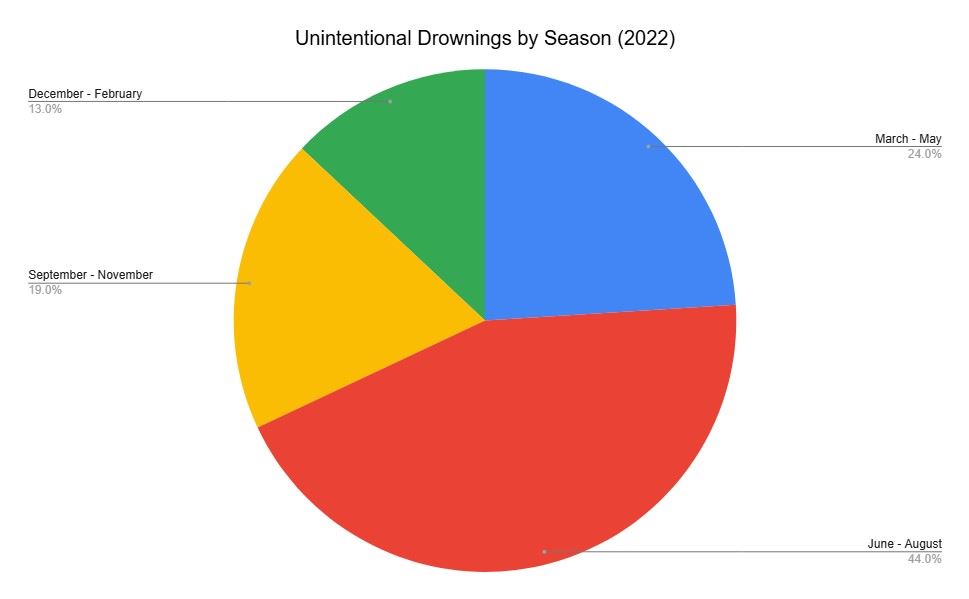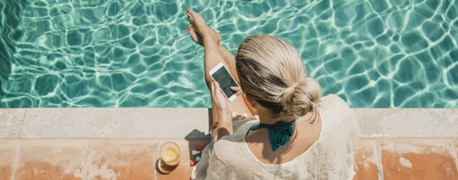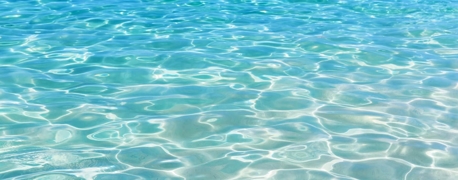Drowning—It’s Not Just a Summer Issue: Off-Season Risks You Deserve to Know

Water safety and drowning prevention campaigns tend to get the most attention during the summer, and most injuries and deaths do happen in June, July, and August—but unintentional drowning is a year-round issue. From young children slipping into hotel pools during winter break to teens being swept away by swollen rivers in the spring, drowning occurs in every season. In 2022, there were 2,506 unintentional drowning deaths in the United States from September through May (CDC WISQARS).
Understanding how—and why—these off-season tragedies unfold is the first step toward stopping them.
How Drowning Risks Shift When Summer Ends
September, October & November
As summer turns to fall, schools reopen and families return to their normal routines. In many parts of the country, however, temperatures remain warm, and swimming may continue in pools and natural bodies of water through September and even early October. Then, every state except Hawaii and Arizona marks the end of daylight saving time by turning the clocks back one hour—and losing an hour of daylight at the end of the day.
Fall drowning risks come with earlier sunsets, heavy autumn rains that swell creeks and rivers, and even Thanksgiving vacations to hotels and resorts with pools that remain open to tourists year-round. According to CDC WISQARS, there were 834 unintentional drowning deaths in the U.S. during September, October, and November of 2022. These accounted for nearly 19% of all drowning deaths that year.
December, January & February
When winter approaches and then hits with full force, cold weather doesn’t stop water hazards. In many cases, it disguises them. Thin ice on lakes and ponds may tempt skaters, sledders, and snowmobilers, but a single weak spot can send someone plunging into 30°F water that paralyzes muscles in under a minute. Even regions of the country that do not experience freezing temperatures and frozen bodies of water present winter drowning hazards. Water that is between 50-60°F can lead to “cold shock” and drowning—causing death within a few seconds or minutes. A playful plunge into a lake or swimming pool can turn deadly if the water is cold.
Winter storms may bring flash flooding when rain falls on frozen ground, turning roadways into rivers. Indoors, hot tubs and bathtubs become high-risk zones at holiday gatherings, and water attractions during holiday trips to warmer climates present their own risks. Guests can lose consciousness quickly in overheated spas and slip beneath the surface unnoticed.
Winter drowning risks come with cold temperatures, cool or freezing water, and heavy weather. Although winter months have the fewest drowning fatalities, 575 people lost their lives due to unintentional drowning in December, January, and February of 2022. Winter accounted for nearly 13% of all drowning deaths in the U.S. that year.
March, April & May
Spring is the second most dangerous season for drowning deaths, accounting for just over 25% of unintentional drowning fatalities in the U.S. in 2022. During the months of March, April, and May, 1,088 people lost their lives due to unintentional drowning.
During the spring, snow melts and feeds rivers and reservoirs, creating powerful currents weeks before beaches officially open. Early-season boaters may skip life jackets because the air feels mild, yet the water is still frigid enough to trigger cold shock and drowning. Spring break trips amplify the threat: teens and college-age swimmers crowd unguarded hotel pools and coastal inlets, bringing alcohol, peer pressure, and nighttime swims into the mix.
Some may assume drowning is a summer-only danger, but water hazards simply change form as the weather shifts.

Cold Water & “Silent” Submersions
Falling temperatures mean cooler water, both in natural bodies of water (lakes, rivers, oceans, and creeks) and in swimming pools and spas. Cold water is a year-round killer because it attacks the body differently than warm water ever can. The moment water below 60°F hits the skin, cold shock may kick in: vessels clamp down, the heart rate spikes, and an involuntary “gasp” reflex floods the lungs with air—or water if the face is submerged.
Researchers have documented life-threatening cardiac arrhythmias within the first 30 seconds of immersion and loss of breathing control that can last over 1 minute. Even strong swimmers are helpless during that window; a single mistimed wave or splash can turn the gasp into a fatal inhalation. Because the victim’s airway never breaks the surface, bystanders often see only a brief flail—then nothing. Rescuers later report finding motionless bodies in calm water just a few feet from safety: the classic “silent” submersion.
If cold shock doesn’t finish the job, swimming failure often will. At 50°F, a fit adult can lose the ability to coordinate arm strokes in as little as two minutes, and fine motor control of the hands can vanish in 60 seconds. Without a life jacket, the swimmer’s head drops, inhalations fill the lungs with water, and drowning follows quickly—again with little surface struggle.
Hypothermia, the danger everyone expects, is usually the third threat in the chain. It may take 30 minutes or more to develop, but only if the victim survives those first violent moments. According to the U.S. Coast Guard, more than 50% of cold water deaths occur before hypothermia sets in.
Bathtubs, Swimming Pools & Hot Tubs
The American Academy of Pediatrics (AAP) reports that most infants drown in bathtubs or large buckets. Most preschool-aged children drown in swimming pools. Even older children, teens, and adults may face drowning risks in hot tubs and pools in use during the spring, fall, and winter. Indoors and out, unintentional drowning may occur any day of the year.
Spring Floods & Winter Storms
Statistics presented by the National Weather Service show that flooding kills more U.S. residents annually than lightning, tornadoes, or hurricanes. In addition to flooding caused by storms, spring rains and melting snow can bring rivers, creeks, and other natural bodies of water to dangerous levels with swift, hidden currents. Older children and teens are more likely to drown in natural bodies of water—and they face these drowning risks all year long.
Travel Season Drownings: Hotels, Rentals & Cruise Ships
Spring break, winter holiday vacations, and other travel can turn deadly when water is involved. Drowning risks are present in every season while vacationers visit warmer regions or resorts with water features of any kind.
Travel drowning dangers include:
- Hotels & Resorts: Pools, lazy rivers, and hot tubs at many resorts are open year-round, sometimes operating without lifeguards or with reduced staff in the off-season. Drowning risks are still present, however, anytime there is water present.
- Short-Term Rentals: VRBO and Airbnb listings with backyard pools may lack fencing, pool alarms, or posted rules. This is a risk at waterfront rentals as well, especially if properties have attached docks, canoes, or kayaks designated for guest use.
- Cruise Ships & Water Parks: From wave pools to water slides and even specified “children’s areas,” attractions on cruise ships and at water parks present dangers when poorly maintained or improperly supervised.
Swimmers Deserve to Be Protected, No Matter the Season
Whether it is a community pool in October, a hotel spa in January, or a riverfront rental in May, the duty to protect swimmers is constant. Commercial property owners, resort chains, cruise lines, and recreation managers must take reasonable measures to protect guests of all ages from drowning and other water-related risks.
All year long, these parties must:
- Maintain Barriers & Alarms: Locked gates, self-latching doors, pool covers, and audible water-entry alarms are proven lifesavers. Off-season maintenance is not optional; a broken latch in February is every bit as deadly as one in July.
- Staff & Train Lifeguards Appropriately: Cutting hours when tourist traffic slows may save payroll, but it removes the single most effective layer of drowning prevention: supervision. If a pool is open, trained supervision should be on duty.
- Inspect & Repair Equipment: From faulty pool drains to handrails and lighting, year-round inspections catch hazards before they claim lives. Neglected pumps, missing drain covers, or faulty wiring can turn a relaxing swim into a fatal trap.
- Post Clear Rules & Enforce Them: Depth markers, “No Diving” signs, life jacket requirements, and alcohol restrictions only work when management enforces them consistently, regardless of season or guest volume.
- Plan for Weather & Water Conditions: River guides, marina operators, and waterfront landlords must post warnings, provide life jackets, and close access when currents or temperatures present drowning risks.
When businesses ignore these basics, preventable drownings follow. Seasonality is no defense. Swimmers deserve safe facilities and diligent oversight every day of the year. No excuses. No shortcuts. No matter what.


